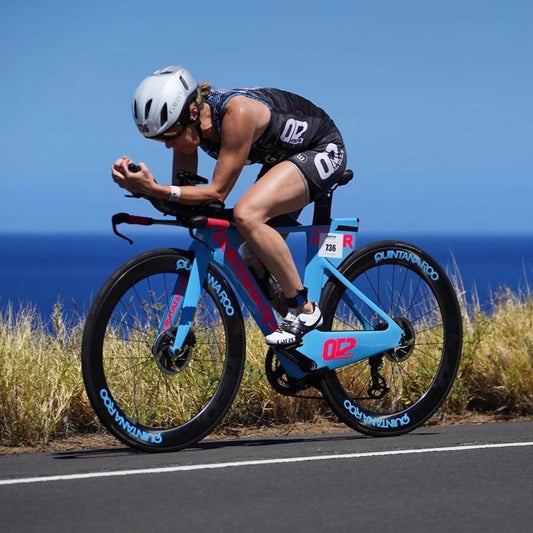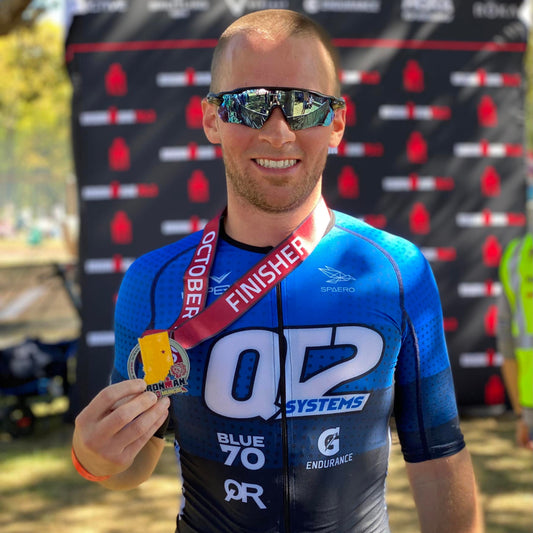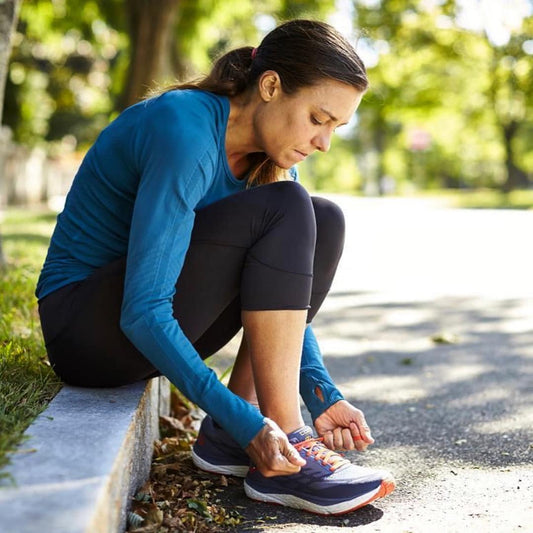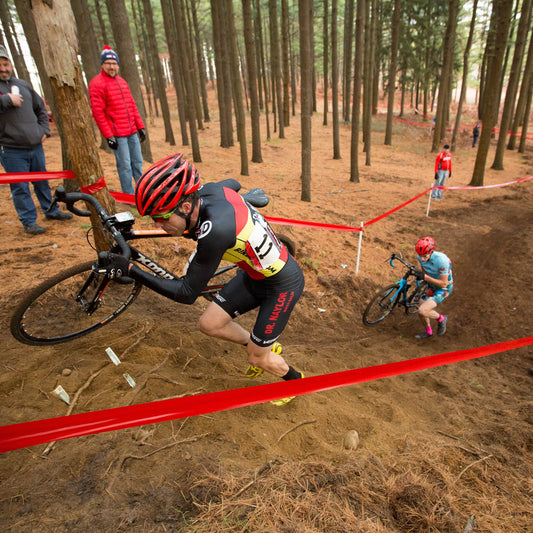Run Mechanics
Swim mechanics and bike fitting get all of the hype these days. As triathletes, we are often keenly aware of our mechanical faults in the water, and how to make our bike position as powerful and aerodynamic as possible. The mechanics of running, however, have not yet received the respect that they deserve, until now! My goal, with this writing, is to help triathletes, and runners alike, to overcome many of running's common mechanical pitfalls.
Running mechanics is a topic that many athletes feel is of little consequence. But, running mechanics can mask an athlete's true fitness and speed potential, especially at the Ironman distance, where many of the supporting muscle groups become so fatigued late into the race. These inefficiencies typically combine with an already slowing "engine", and lead to very slow marathon splits, relative to the athlete's open running ability (greater than 12% decouple). This occurs on a regular basis at both the elite and age group levels, and can often be avoided by paying run mechanics the same level of attention afforded by swim technique and bike fit.
The goal of Ironman running is to bring as much of your open running abilities into the race as possible. We like to see no more than an 12% decouple between an Ironman run split and an open run time. To this end, it is important to maintain an anabolic mental state. Anabolic? You bet! Chest out and head up, like a sprinter exploding across the finish line. That is what I mean by anabolic. This is in direct contrast to the catabolic carriage, which is evidenced by a crumbling posture and negative state of mind. Obviously, it is unlikely that any of you are going to cross the finish line of your next Ironman looking like Usain Bolt. But, that should certainly be the ideal that we strive for, and close attention to running mechanics is our fastest ticket in getting there.
How do we reach this anabolic state of mind? The answer is in addressing and eliminating the issues that lead to a catabolic state that currently haunt may haunt you. Poor flexibility, weakness in non-primary muscle groups, a cognitive inability to find proper posture, and mental weakness on race day can all contribute to your catabolic state. So, with these items in mind, let's consider the most common areas of deficiency seen in runners and triathletes. While we're at it, we'll discuss how these can be fixed before they derail the fitness that we have worked so hard to produce.
Poor extension
This is measured by how far behind the body your leg (i.e. femur) extends during the recovery phase of your running stride. I typically like to see a minimum of 16 degrees of femur extension off of the vertical. This quality is critical in good running posture, because it typically leads to a higher running cadence. By extending the femur further behind the body, your lower leg tends to recover much higher and closer to your rear-end. With this higher recovery, the lever created from your hip, down has less rotational mass and is therefore in a position to recover forward, faster. This faster forward recovery leads to a higher running cadence and, most times, a better strike location relative to your upper torso position.
By now, most runners have realized that a higher running cadence is critical to reducing fatigue, increasing speed, and reducing the possibility of injury. Due to this realization, many runners have begun running with a higher cadence simply by heading out the door and thinking about the need to run with a faster cadence. This approach typically leads to hip flexor injuries due to an increased load on the hip flexors. The key to a proper increase in running cadence is good upper torso position and hip flexor flexibility, which greatly improves femur extension.
Upper Torso Position
This is the position of your body from your waist to your ear, relative to the vertical position. Ideally, I like to see the upper torso at a forward angle of about five to ten degrees off of vertical. Upper torso position is critical to improving running cadence and a foot strike that falls beneath the body. This improved foot strike position reduces braking forces and vertical bounce. A good upper torso position also permits the upper quad and psoas a bit of "slack", allowing for good extension, as discussed above. While creating a good upper torso position is very much cognitive in nature, it also requires good soleus flexibility. Many triathletes lack this flexibility, leading to poor running mechanics, and many times, Achilles tendonitis and/or planter fasciitis. Extreme vertical bounce in a runner's gait quite obviously leads to slower than necessary run times, as the balance of time moving vertically is NOT spent moving horizontally. This extreme vertical bounce can also overload the hips in, most cases upon contact with the ground. An additional one to two inches of vertical bounce, beyond normal, can relate to as much as 300 to 600 feet of vertical climbing in a flat 40-minute 10K, running at 90 steps per minute. This vertical bounce essentially creates hills where they are not!
So far, we have discussed two flexibilities that are critical to good running mechanics: soleus flexibility and hip flexor/upper quad flexibility. These are the very same areas that become very tight with frequent riding in the aero position. Therefore, it is with no surprise that we see so many poor running strides on the marathon course of any Ironman.
Hip Drop
This is best evaluated through video run analysis, and is presented by the dropping of one or both of the hips, upon foot strike and weight transfer. Drawing a horizontal line across the very tops of the hip bones, a drop of more than 14 degrees can be indicative of weak gluteus media and/or TFLs. A good video analysis will very easily identify too much hip drop and the effects that it has on your running stride. From behind, this hip drop can be seen as a zig-zag pattern that starts at the feet, extending up through the hips, back, and head. Upon the striking and dropping of the hip, we essentially see all of these body parts going in different lateral directions. The legs and hips end up leaning in different directions. The back follows the legs, and the head follows the hips. Hence, the zig-zag effect! This is a major chain-reaction of lateral deflection being directed in opposite directions. For example, with a weak left gluteus medius the right hip drops and the left hip leans to the left, causing the legs and back to actually lean to the right. And, in a last ditch effort to keep the body from falling over, the head goes the way of the hip, leaning to the left. All of this, when our aim is to run neither left nor right, but forward! The required unnecessary compensatory muscle contractions related to this lead to an added usage of muscle glycogen, at a time when we are doing our best to preserve it. Furthermore, the hip drop also tends to contribute to a lower running cadence, because more time is spent in contact with the ground, upon foot strike and rebound. The more energy that can be put into moving forward, rather than left, right, up, or down, the faster that you will be.
Lack of Shoulder Rotation
This is a measure of how much your shoulders rotate about your torso while running. The shoulders play an integral role in efficient running posture. Many athletes are under the false impression that they should be running with a very square shoulder position. In fact, it is just the opposite as the best runners actually use their shoulder mass as a tool to help propel them forward, late in races when their lower bodies becomes extremely fatigued. A lack of shoulder rotation tends to be cognitive in nature and/or related to a weakness in rotational core strength. A strong upper torso rotation, late in the run, requires a great deal of rotational core strength, as the athlete is relying solely on the soft-tissue strength of their core to facilitate the rotation.
Dropped Arm Position
This relates to the position of your arms throughout the run stride. Both dropped arm and "elbows out" positions are typically the result of hip weakness and/or cognitive habit. Typically, runners with weak hips on one or both sides tend to drop their arm on the side of the weak hip, in an effort to pull the body back over to that side. This is one of those inefficient compensatory motions that slow runners down. These arm positions tend to limit cadence as more rotational mass is presented in the form of more arm mass further away from the shoulder. This can actually limit run cadence! Most world-class runners exhibit the same acute elbow angle deep into their recovery posture, as they maintain during the drive portion of their arm swing. It is as if the elbow is being pulled directly back from its most forward position with a fishing line!
Compensation for any of the above identified deficiencies fall into two different categories, namely cognitive and improvements in strength/flexibility. Those cognitive in nature require the runner to make mental changes to their posture while running. Below, I focus on the best, most targeted, run-specific stretching and strengthening exercises, to address the deficiencies identified above.
These exercises are those that I most commonly prescribe to athletes, following a detailed running mechanics assessment. Each of these directly impact one or more of the above critical areas, required for great running mechanics.
1) Single Leg Squat - This is the single most commonly prescribed functional strength move that I use with the athletes who I assess. They can be done with a TRX, standing alone in your living room, or in the gym on a smith machine. In each of these cases, the eccentric loading that must be resisted by your hips helps to eliminate hip drops through strengthening of the glut medius and TFL, among other muscle groups.
2) Eccentric Calf Raises - This is the second most commonly prescribed run-specific strength/flexibility move that I prescribe. It helps to create a better forward upper torso position, leading to a higher running cadence and much reduced braking force. This move also practically eliminates below the knee soft tissue injuries.
3) Two Joint Hip Flexor Stretch - This move is very run-specific and really helps to target the hip flexors and upper quads, which are areas that are chronically tight in triathletes, due to high cycling volumes. For many years I prescribed a traditional psoas stretch to help fix very short extensions, as discussed above. However, I later realized that the two joint stretch was more functional, helping to engage the upper quad, and critical to creating better extension and running cadence.
4) Hill Bounding - This is better categorized as a key workout, but in many cases can help to lead to better running mechanics. Initially introduced by Coach Arthur Lydiard, I have successfully used this workout, with my athletes, for the past 10 years as a key workout AND run mechanics drill.
5) Rotational Core Work - By now, almost all athletes have realized the importance of core strength. What many athletes fail to realize is that rotational core strength is more important as a functional exercise! Practically any core specific abdominal move is fine, as long as it has a rotational component. For example, bicycle crunches.
Most of the primary movers related to running receive plenty of stress from the training program. But, in most cases, these more peripheral items tend to be underworked. In fact, the integration of these five moves into your regular functional strength routine, can help to fix poor running form, or maintain already strong technique. Just two sets of each, once or twice each week, is all that is required.
Translating even great running mechanics and great open run times into Ironman takes a great deal of work, beyond simply muscle strength, fitness, and flexibility. This task requires the creation of a very confident, anabolic atmosphere while on the run course. Alongside well-developed day-to-day nutrition and race day fueling programs, proper running mechanics allow an environment to begin the positive process while the other items, including proper pacing, make it all come together on race day!
-Jesse





